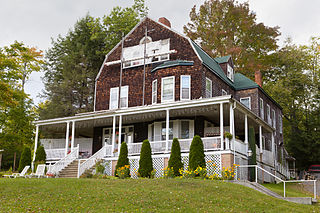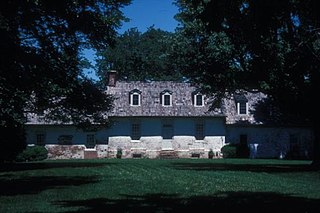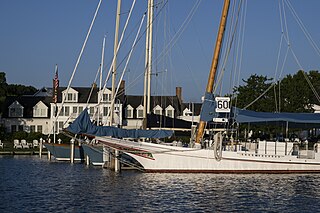
The Cray House is a two-room house in Stevensville, Maryland. Built around 1809, it is a rare surviving example of post-and-plank construction, and of a build of small house which once dominated the local landscape. For these reasons it was listed on the National Register of Historic Places in 1983.

The William Paca House is an 18th-century Georgian mansion in Annapolis, Maryland, United States. Founding Father William Paca was a signatory of the Declaration of Independence and a three-term Governor of Maryland. The house was built between 1763 and 1765 and its architecture was largely designed by Paca himself. The 2-acre (8,100 m2) walled garden, which includes a two-story summer house, has been restored to its original state.

The Old Inn, also known as the Old Brick Inn, was built circa 1816 in Saint Michaels, Maryland. It is unusual for Maryland in possessing two-story porches on both its front and back sides.

The Carolina Inn is a hotel listed on the National Register of Historic Places on the campus of the University of North Carolina at Chapel Hill in Orange County, North Carolina, which opened in 1924. The Carolina Inn is a member of Historic Hotels of America, the official program of the National Trust for Historic Preservation.
The Elkridge Site, or Elkridge Prehistoric Village Archeological Site, is an archaeological site near Elkridge in Anne Arundel County, Maryland. It is located on a 20-foot (6.1 m) terrace above the Patapsco River and extends 1,200 feet (370 m) along the river and inland from 20 to 400 feet. It is the only known Woodland period riverine-oriented village site in the tidewater Patapsco River valley which has at least partially escaped the totally destructive forces of gravel quarrying. The site appears to have been abandoned as a permanent village in the early 16th century.

The Inns on the National Road is a national historic district near Cumberland, Allegany County, Maryland. It originally consisted of 11 Maryland inns on the National Road and located in Allegany and Garrett counties. Those that remain stand as the physical remains of the almost-legendary hospitality offered on this well-traveled route to the west.

The Pennington Cottage is a historic home located at Deer Park, Garrett County, Maryland, United States. It is a 2+1⁄2-story, late-19th-century Shingle-Style frame structure, with a gambrel roof and a one-story porch that stretches across the principal facade and along portions of the sides. The house is entirely covered with dark wood shingles. It was built as a part of the Baltimore and Ohio Railroad's Deer Park Hotel complex, as the summer home of Baltimore architect Josias Pennington.

Jena is a historic home in Oxford, Talbot County, Maryland. It is a 1+1⁄2-story brick structure with 19th- and 20th-century additions. It is faced in Flemish bond and distinguished by its first-story 9/6 windows with unusual canted and paneled reveals.
The Wye Town Farm House is a historic home in Easton, Talbot County, Maryland, United States. It is of brick construction, one and one-half stories high and two rooms deep with a small one-story brick kitchen. A two-story addition was made in the 20th century. The original section of the house dates from about 1800.

Old Bloomfield is a historic home at Easton, Talbot County, Maryland, United States. It is a large and sprawling structure constructed in three major sections: a 1+1⁄2-story, three bay brick section with a steeply pitched roof built about 1720; a 1+1⁄2-story frame addition on the southwest gable built about 1840; and a 2-story frame wing on the southwest end of this earlier addition. Also on the property is a small frame dairy, a heavy timber-frame crib, and a barn. It has remained in the same family as a working farm continuously since the 17th century.
Rock Clift, or High Banks, is a historic home at Matthews, Talbot County, Maryland, United States. It is a two-story, three-bay Flemish bond brick house with dormers and has a one-story four-bay frame addition that was built in two sections. The brick house appears to date from about the 1780s.

Brooklandville House, or the Valley Inn, is a historic restaurant and tavern building, and a former inn, located in Brooklandville, Baltimore County, Maryland. It is a 2+1⁄2-story stone structure facing the former railroad and dating from about 1832. It is associated with the Baltimore and Susquehanna Railroad, which crossed the property just to the south.

Clark's Conveniency is a historic home located near Pomona, Kent County, Maryland, United States. It is a 1+1⁄2-story, early-18th-century brick house built in three sections: the main block and a wing on the east and west ends. It is representative of the houses built by the smaller but still prosperous planters of 18th-century tidewater Maryland.
The Persistence is a Chesapeake Bay log canoe, built in the 1890s, possibly by John B. Harrison in Tilghman, Maryland. She measures 32'-41⁄2" long, with a beam of 6'-111⁄2" and is double-ended with no longhead on her bow. She is one of the last 22 surviving traditional Chesapeake Bay racing log canoes that carry on a tradition of racing on the Eastern Shore of Maryland that has existed since the 1840s. She is located at St. Michaels, Talbot County, Maryland.

Bishopton is a historic home located at Church Hill, Queen Anne's County, Maryland. It is a 1+1⁄2-story, brick dwelling, three bays wide, and one room deep with a hall-parlor plan in the 18th century Tidewater Maryland/Virginia vernacular style It was built about 1711. The facades are laid in Flemish bond and the upper gables feature glazed chevron patterns.
The John Embert Farm is a historic home located at Millington, Queen Anne's County, Maryland, United States. It is a 1+1⁄2-story Flemish bond brick house with a two-bay facade. The building is an exceedingly rare and almost pristine example of a small-scale Tidewater house.

The Minnie V is a Chesapeake Bay skipjack, built in 1906 at Wenona, Maryland, United States. She is a 45.3-foot-long, two-sail bateau, or "V"-bottomed deadrise type of centerboard sloop. She has a beam of 15.7 feet and a depth of 3 feet with a net registered tonnage of 8 tons. She is one of the 35 surviving traditional Chesapeake Bay skipjacks and a member of the last commercial sailing fleet in the United States. She is located at Tilghman, Talbot County, Maryland.
The Nellie L. Byrd is a Chesapeake Bay skipjack, built in 1911 at Oriole, Maryland. She is a 53.6' long two-sail bateau, or "V"-bottomed deadrise type of centerboard sloop. She has a beam of 26.7', a depth of 4.8', and a net tonnage of 18 tons. She is one of the 35 surviving traditional Chesapeake Bay skipjacks and a member of the last commercial sailing fleet in the United States. When listed, she was located at Tilghman, Talbot County, Maryland. Since 2005, she is located at Middle River, Maryland, Baltimore County, Maryland.

The Stanley Norman is a Chesapeake Bay skipjack, built in 1902 by Otis Lloyd, Salisbury, Maryland. She is a 48-foot-3-inch-long (14.71 m) in Length overall with length on deck (LOD) OF 47.5-foot-long (14.5 m) two-sail bateau, or "V"-bottomed deadrise type of centerboard sloop. She has a beam of 16 feet (4.9 m), a depth of 4 feet (1.2 m) at the stern with the centerboard up, and a registered tonnage of 7 tons.
The Doncaster Town Site is an archeological site near Easton, Talbot County, Maryland. The site is located on one of the earliest land grants in Talbot County, surveyed on October 18, 1658. It is the location of the first Roman Catholic Church erected on the Eastern Shore of Maryland. The town was erected in 1684 and was one of the first planned towns in Maryland. At its peak Doncaster would have contained inns, a chapel, warehouses, a ferry, stores, stocks and a whipping post, a public square, and a number of residences. Archeological deposits were recorded in 1961.

















